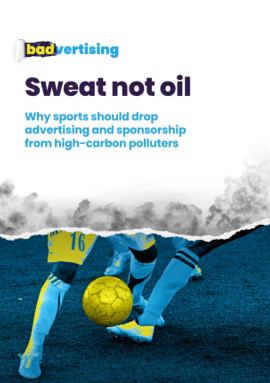Sport and sponsorship
At the 2021 Australian Open tennis championships the prominent courtside sponsors included a fossil fuel company, an airline and a car maker. High-carbon sponsorship of sport has, in many ways, replaced once common and now disgraced deals with tobacco companies.
Sport used to rely heavily on tobacco sponsorship until the importance of public health overcame vested interests and largely ended the practice. In 1990 more than 20 different televised sports were sponsored by cigarette brands in the United States alone, and a single tobacco company, RJ Reynolds, admitted in 1994 to sponsoring 2736 separate sporting events in a year.
Today the world faces a climate emergency and sport is floating on a sea of high carbon sponsorship. In our report we found over 250 prominent deals across multiple sports.
“As athletes, we focus a lot on keeping sport “clean” through prioritising anti-doping. Yet continuing to pollute in the face of the climate emergency is the Earth-equivalent of doping, or scoring own goals. By keeping polluting sponsors on board, sports detract from their opportunity to play a productive part in the race to zero carbon. It’s time for sports and athletes to change that.”
– Melissa Wilson, member of the GB Rowing Team and qualifier for the Tokyo Olympics.
The issues this raises for sport are several.First of all, from the melting of winter sports, to the flooding of football grounds and the cancellation of flagship sporting events due to heatwaves and air pollution, global heating and the emissions that cause it are a huge problem. Secondly, sport itself is contributing to the problem directly through all the emissions linked to it. Thirdly, direct association with promoting high carbon products and lifestyles not only contradicts the pledges of climate action that many clubs and sports bodies are beginning to endorse, but it poses an increasing reputation risk to sport, which is meant to represent a better, healthier way of life.
High carbon sponsorship in figures
● The report found a total of 258 sports sponsorship deals in various countries with companies promoting high-carbon products, services and lifestyles
● These deals ranged across 13 different sports categories: football, american football, cricket, the Olympics, tennis, sailing, cycling, athletics, basketball, rugby, golf and motorsport.
● Over 10 different sports categories are listed: clubs, teams, associations, leagues, federations, races, championships, tours, tournaments, and stadiums.
● By sport: football is the most targeted by advertising with 57 high-carbon sponsorship deals.
● By sector: the auto industry is the biggest sponsor numerically with 199 deals. Airlines come second with 63 sports partnerships. The high profile fossil fuel companies Gazprom and Ineos are also prominent.
● By company: the carmaker Toyota is the largest sponsor – 31 deals identified – followed closely by the airline Emirates with 29 partnerships.
What are we calling for?
The Badvertising campaign is calling for sports bodies around the world to end advertising and sponsorship deals from companies promoting high carbon lifestyles, products and services.
 The global sports industry was worth an estimated $471 billion in 2018. Corporate sponsorship in sport is a multi-million dollar business but do we really know where the money is coming from? A new report out today from the New Weather Institute, Possible and the Rapid Transition Alliance for the Badvertising campaign, identifies advertising and sponsorship deals with major polluters across 13 different sports, including football, cricket and tennis, to major events such as the Olympics. This is despite moves in the last year by the sports industry to reduce their carbon emissions and play a bigger role in tackling the climate crisis.
The global sports industry was worth an estimated $471 billion in 2018. Corporate sponsorship in sport is a multi-million dollar business but do we really know where the money is coming from? A new report out today from the New Weather Institute, Possible and the Rapid Transition Alliance for the Badvertising campaign, identifies advertising and sponsorship deals with major polluters across 13 different sports, including football, cricket and tennis, to major events such as the Olympics. This is despite moves in the last year by the sports industry to reduce their carbon emissions and play a bigger role in tackling the climate crisis.